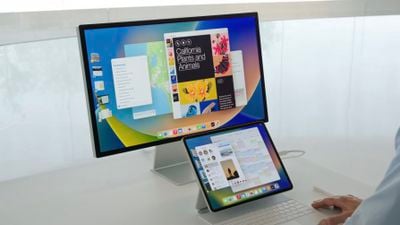Following the WWDC keynote last week, Apple’s software engineering chief Craig Federighi spoke with TechCrunch‘s Matthew Panzarino about the new Stage Manager feature for iPad and Mac. Notably, he elaborated on Stage Manager being limited to M1 iPads.
On the iPad, Stage Manager allows users to resize apps into overlapping windows for an improved multitasking experience. Stage Manager also fully supports an external display with up to 6K resolution, allowing users to work with up to four apps on the iPad and up to four apps on the external display simultaneously.
In a statement shared with Rene Ritchie last week, Apple asserted that Stage Manager “requires large internal memory, incredibly fast storage, and flexible external display I/O, all of which are delivered by iPads with the M1 chip.” Federighi elaborated on that rationale in his chat with Panzarino, telling him that the power of the M1 chip ensures that all apps being used in Stage Manager are “instantaneously responsive.”
“It’s only the M1 iPads that combined the high DRAM capacity with very high capacity, high performance NAND that allows our virtual memory swap to be super fast,” said Federighi. “Now that we’re letting you have up to four apps on a panel plus another four – up to eight apps to be instantaneously responsive and have plenty of memory, we just don’t have that ability on the other systems,” such as the previous-generation iPad Pro.
Released in April 2021, the iPad Pro with an M1 chip is available with up to 16GB of RAM, compared to 6GB in the previous iPad Pro. Apple also advertises the M1 iPad Pro as having 2x faster storage and up to 40% faster GPU performance compared to the previous model. Apple also released an iPad Air with the same M1 chip in March 2022.
“We really designed Stage Manager to take full advantage [of the M1 chip],” said Federighi. “If you look at the way the apps tilt and shadow and how they animate in and out. To do that at super high frame rates, across very large displays and multiple displays, requires the peak of graphics performance that no one else can deliver.”
“When you put all this together, we can’t deliver the full Stage Manager experience on any lesser system,” added Federighi. “I mean, we would love to make it available everywhere we can. But this is what it requires. This is the experience we’re going to carry into the future. We didn’t want to constrain our design to something lesser, we’re setting the benchmark for the future.”
As for Stage Manager on the Mac, Federighi said there are already “so many different ways” to multitask on macOS, such as using Mission Control or the Command-Tab keyboard shortcut to switch between apps, and Stage Manager is simply another tool in the toolbox.
“On the Mac, there are so many different ways to work. Some people use spaces, some people are in and out of Mission Control. Some people are command tab people, some people like to create a mess, some people clean up their messes and some people use minimization. I mean, there’s no wrong answer here, there are a lot of valid ways to work on the Mac.”
“If 20% of the users on the Mac end up saying that this is another great tool in the quiver for them… that’s fantastic,” he said.





